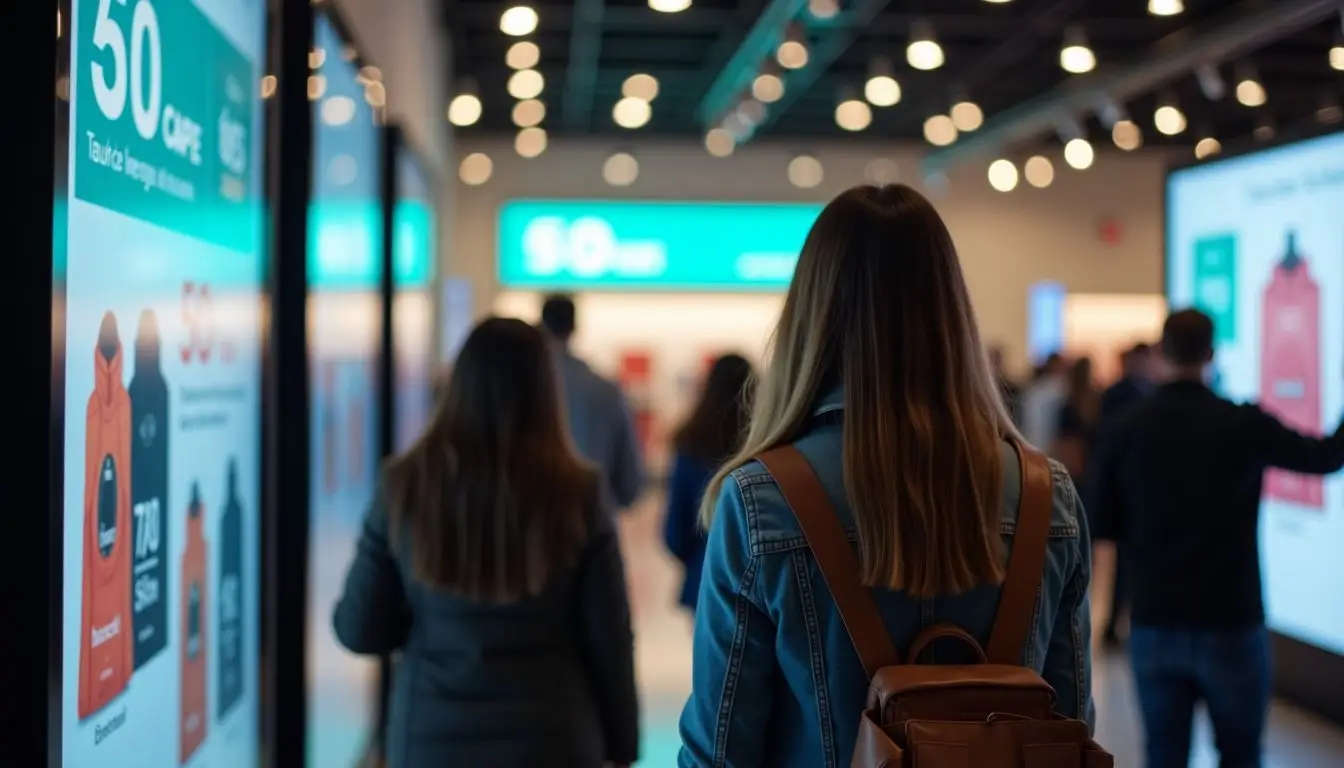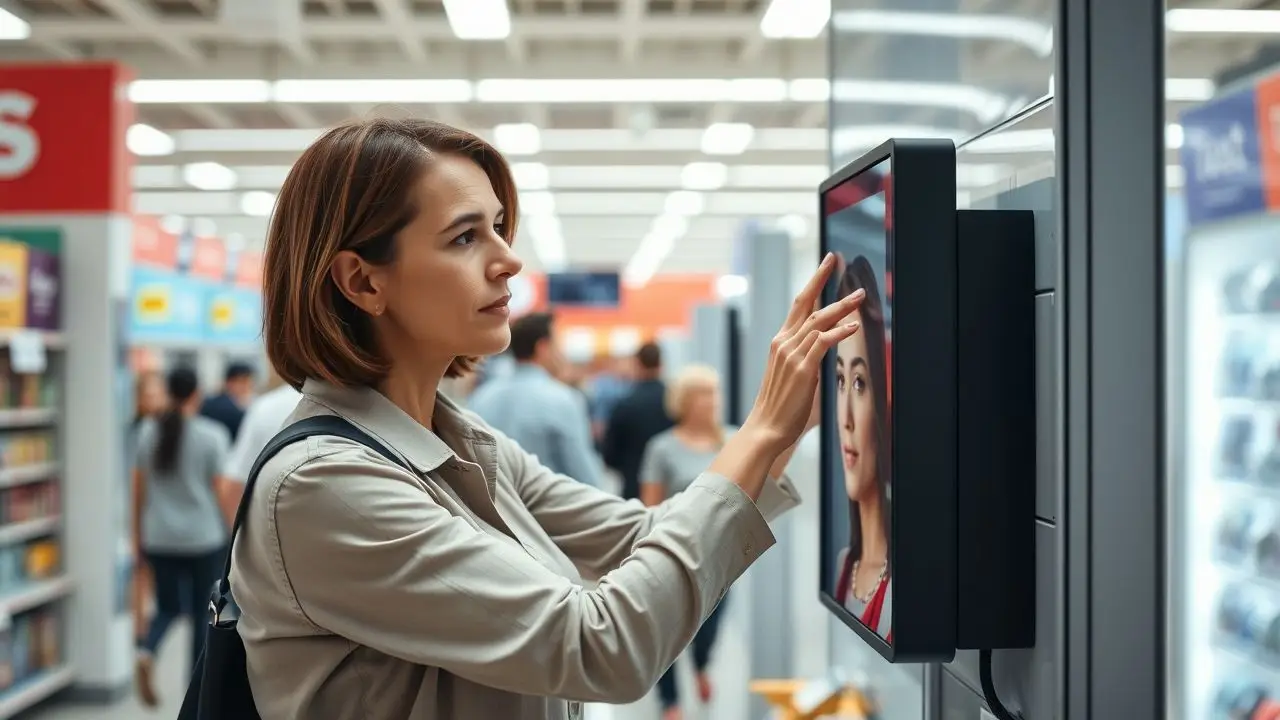Keeping up with tech is hard for stores. One fact stands out: digital signage is booming in retail. This post will show why it’s smart to use these signs. Keep reading to learn more.
Key Takeaways
- Digital signage helps stores catch attention and sell more. It shows ads, deals, and news. This tech makes shopping fun and keeps customers coming back.
- Stores use digital signs more each year. From 2019 to 2022, the number of retailers using this tech grew by 30%. Signs can boost sales by up to 30%.
- Good digital signage needs planning. Retailers should pick easy software and train staff well. They also need to keep content fresh and follow rules.
- Examples like McDonald’s show how digital screens help sell food faster. Sephora uses them too so customers can learn about beauty products in a fun way.
- Using signs is cost-effective because it saves money on printing. Plus, it attracts shoppers right where they decide what to buy, leading to more sales for the store.
Table of Contents
ToggleThe Growing Trend of Digital Signage in Retail

Digital signage is becoming popular in retail. It helps stores grab attention and connect with customers better.
Definition of digital signage

Digital signage is a form of electronic display. It shows content like images, videos, or messages. Retailers use it to communicate with customers and advertise products.
These displays can be found in stores and malls. They often catch the eye of shoppers. Many brands choose digital signage for its ability to boost customer engagement. This technology allows quick updates on promotions too.
In fact, research shows that digital signs increase sales by 30%. Brands see it as a key part of their marketing strategy to stay competitive in an ever-changing market.
Why retailers are investing in it

Retailers invest in digital signage to engage customers better. This technology grabs attention and makes shopping more fun. Stores can show bright ads, special offers, and important updates.
About 70% of buyers say they remember brands from digital displays. This helps stores stand out.
Interactive displays also allow for personalized marketing. They create an immersive retail environment where shoppers feel connected to the brand. Retailers see a rise in sales as these tools improve customer experience.
Digital signage is now a key part of many sales strategies in retail business today.
Citing statistics on its popularity

Digital signage is getting more popular in retail. Many stores use it now. This shows in the numbers.
| Year | Number of Retailers Using Digital Signage | Percentage Increase |
|---|---|---|
| 2019 | 40% | N/A |
| 2020 | 50% | 25% |
| 2021 | 60% | 20% |
| 2022 | 70% | 16.7% |
More stores add digital signs every year. From 2019 to 2022, the use grew by 30%. This shows stores like digital signs a lot. They help stores sell more and talk to customers better.
Benefits of Digital Signage for Retailers

Digital signage helps retailers connect with customers better. It allows them to share updates and special offers instantly, making shopping more exciting.
Increased customer engagement
Customers are drawn to interactive displays. These digital signs catch their eye and spark interest. Retailers use this technology to create engaging experiences. Customers often respond better when they see lively visuals or promotions.
Studies show that stores with digital signage notice a boost in sales. One report found that 70% of customers remember ads displayed on screens. This means signs can change shopping behaviors and increase brand awareness easily.
Personalization also plays a role here, making customers feel valued while they shop.
Real-time updates and promotions
Digital signage allows retailers to share real-time updates and promotions with shoppers. This keeps customers informed about sales, events, or new products. Quick changes can attract more buyers.
For example, a store might display a flash sale on an item for just one day. Shoppers are drawn in by timely offers.
Using digital signs helps create engaging experiences too. Visual merchandising is important for grabbing attention. Bright colors and dynamic content keep shoppers interested. Retailers see increased foot traffic and sales when they use eye-catching displays effectively.
By offering personalized shopping promotions through these signs, businesses connect better with consumer behavior trends.
Cost-effective advertising
Retailers find digital signage a smart choice for cost-effective advertising. It allows stores to change promotions quickly without printing new materials. This saves money and time.
Many retailers report better results with digital signs compared to traditional ads.
Using digital displays can boost sales and attract more customers. For example, 60% of shoppers notice in-store screens. These signs engage customers visually and inform them about deals right at the point of sale.
Increased visual engagement leads to higher customer interest, which often means increased sales for businesses that embrace retail technology like this.
Addressing Challenges in Digital Signage Integration

Addressing challenges in digital signage integration requires careful planning and clear strategies. Retailers must ensure that content is relevant and of high quality. They also need to focus on strong network connections for reliability.
Training staff is key for success. Measuring the return on investment helps track effectiveness. There are various regulations to follow too. To learn more about these points, keep reading!
Thorough planning and strategy development
Thorough planning is key for using digital signage well. A strong strategy can help retailers succeed.
- Identify goals for your digital signage. Set clear aims like boosting sales or enhancing brand differentiation.
- Assess current technology in the store. Evaluate existing systems to ensure they support new electronic signage.
- Choose the right software for your needs. Look for features that aid instore marketing and customer engagement.
- Create relevant content that speaks to customers. Ensure promotions match their interests to increase effectiveness.
- Plan how to integrate digital signage into your store layout. Make sure displays are easy to spot and not obstructive.
- Train staff on how to use the new system effectively. Well-informed employees will help create immersive retail environments.
- Establish a schedule for regular content updates. Frequent changes keep the audience engaged with fresh promotional displays.
- Monitor performance regularly with analytics tools. Measuring ROI helps in fine-tuning your sales strategy over time.
- Comply with all local regulations regarding advertising displays. Stay informed about rules to avoid potential issues.
- Gather feedback from customers about the digital signage experience. Understanding their opinions offers insight into improving future strategies.
These steps will help retailers make smart choices with their digital platforms while improving customer interaction and overall sales success.
Content relevance and quality
Content must relate to the audience. It should speak directly to their needs and interests. Retailers can use digital signage to show fresh content that grabs attention. Showing new products or promotions keeps customers engaged.
Quality matters, too. High-quality images and videos attract shoppers. They make stores appear modern and inviting. First-hand experience shows that well-made signs lead to more sales.
Successful retailers invest in good content for better customer experience in their stores.
Network connectivity and reliability
Network connectivity is key for digital signage in retail. Displays must connect to the internet to show updates and promotions. A strong network allows retailers to change messages quickly and easily.
Reliable connections keep content fresh, which helps engage customers more.
Poor connectivity can lead to issues. If a display goes offline, it misses out on showing important messages. Retailers should invest in strong networks for their digital marketing efforts.
This ensures smooth operation of point of sale displays and enhances the overall customer experience in stores.
Training and staff adoption
Training staff is key to using digital signage well. Workers need to understand how the system works. This means they should learn about the software and hardware they will use. Good training makes them confident in handling new technology.
Staff adoption can lead to better customer service. Engaged employees can explain offers and promotions clearly. They become a part of the retail innovation that attracts shoppers.
Lastly, when staff embrace these tools, stores create immersive environments that keep customers interested and coming back for more.
Measuring ROI and analytics
Measuring ROI is key for retailers using digital signage. It helps them understand if their investment pays off. Retailers can track how many customers engage with the signs. They can also see changes in sales linked to specific promotions.
Analytics tools provide useful data on customer behavior. For example, they show which messages catch attention and drive foot traffic. This information helps businesses adjust their strategies quickly.
Retailers can refine content based on what works best, boosting engagement and sales over time. Using digital signage aligns well with an omnichannel strategy, enhancing the overall customer experience in stores.
Compliance and regulation
Digital signage must follow rules and regulations. Retailers need to know local laws before putting up screens. Many cities have guidelines on size, location, and content for signs.
Compliance helps avoid fines or legal issues.
Staff training is crucial in these situations. Employees must understand the rules around digital displays. They should know how to update content properly while staying within legal boundaries.
Failing to comply can hurt a store’s image and lead to loss of sales. Investing in digital signage means keeping up with all the necessary regulations to stay competitive in retail today.
Making the Right Choice for Your Retail Business

Choosing the right digital signage software is key for your retail business. You need to consider features that fit your needs and will help engage customers effectively.
Factors to consider in choosing digital signage software
Selecting the right digital signage software is key for retailers. This choice can help keep businesses competitive.
- Ease of use matters. Software should be user-friendly. Staff will not spend time learning complicated systems.
- Flexibility is essential. The software must support different types of content. This includes videos, images, and text.
- Integration capabilities count too. It should work well with existing systems like inventory or customer management tools.
- Content management features help save time. Look for software that allows you to schedule and update content easily.
- Customer support is vital. Good tech support makes a big difference when issues arise.
- Cost plays a role in decision-making. Consider both the initial price and ongoing expenses for updates or service.
- Analytics tools are helpful for tracking success. Retailers can see how effective their digital signage is through data insights.
- Security options must be solid. Protecting your network from breaches is crucial when using digital technology.
- Scalability is important as well. Choose software that can grow with your business as needs change over time.
- Compliance with regulations cannot be overlooked either. Make sure the software meets all industry standards for signage use and content display.
These factors will guide retailers in choosing the best digital signage software to enhance their store’s performance and engage customers effectively.
Key features and their benefits
Digital signage offers key features that help retailers improve their business. These features make stores more engaging and efficient.
- Easy-to-use software allows staff to create and change content quickly. This helps keep messages fresh and relevant to customers.
- High-quality displays catch attention with bright colors and crisp images. They help draw in customers and make products stand out.
- Real-time updates let retailers share news or promotions instantly. This keeps shoppers informed about sales or special offers.
- Customizable templates help create different designs for various campaigns. Retailers can maintain a consistent brand image while adapting to new trends.
- Integration with social media lets stores share online content on screens in real time. This builds excitement around events and encourages customer interaction.
- Analytics tools track how well the content performs. Retailers can see what works best for their store and adjust their strategies accordingly.
- Remote management allows retailers to control multiple displays from one location. This saves time and resources, making it easier to manage multiple stores.
- Interactive screens provide customers with touch options, adding engagement. Shoppers can browse products, view videos, or learn more about items right at the display.
Investing in these key features of digital signage gives retailers an edge in today’s market while enhancing the shopping experience for customers.
Practical applications for stores
Retailers are using digital signage in many practical ways. This technology helps them connect with customers and improve sales.
- Displaying promotions captures customer attention. Signs can show discounts, specials, and limited-time offers.
- Showcasing new products keeps shoppers informed. Stores can highlight the latest items to boost interest.
- Using wayfinders helps customers navigate stores easily. Digital maps point out where items are located.
- Communicating brand messages builds identity. Signage tells customers what the store stands for and its values.
- Posting customer testimonials creates trust. Sharing positive feedback makes other shoppers feel confident in their choices.
- Highlighting events gets people excited about in-store activities. Ads for workshops or gatherings attract more visitors.
- Providing real-time stock updates informs customers of product availability. This reduces frustration when a desired item is out of reach.
- Offering interactive displays engages shoppers directly. Touch screens let users explore products closely or find more details about them.
Incorporating these uses makes stores more lively and attractive to buyers, ensuring they stay competitive in retail markets through effective instore technology like digital signage.
Examples of successful retail digital signage implementation
One good example of successful retail digital signage is McDonald’s. They use bright screens to show menu items and prices. This makes it easy for customers to see what they want quickly.
Sales increased after they added these signs.
Another case is Sephora, the beauty store. They installed interactive displays that let customers explore products in detail. Shoppers enjoy this hands-on approach, and it helps boost sales too.
Both brands show why retailers are investing in digital signage to stay competitive.
Impact on sales and customer experience
Digital signage can boost sales and improve customer experience. It captures attention with bright colors and moving images. Stores see more foot traffic when they use engaging displays.
For example, a coffee shop using digital menus reported a 20% increase in sales after switching from static signs.
Customers enjoy the quick updates that digital signage provides. They can see real-time promotions or new items on display. This helps customers make decisions faster, leading to happier shopping experiences.
A well-placed sign can guide shoppers and enhance their visit to the store.
Conclusion

Retailers are seeing the value in digital signage. It captures attention and boosts sales. Stores can share timely updates and offers easily. This tech helps them stay competitive in a fast-paced market.
Investing in digital signage is a smart move for future success.
FAQs
1. Why are retailers investing in digital signage?
Retailers are putting money into digital signage to stay competitive. It’s a way to attract customers and stand out from other stores.
2. How does digital signage help retailers stay competitive?
Digital signage helps retailers by drawing attention and creating a unique shopping experience for customers. This can make their store more appealing than others.
3. What benefits do retailers get from using digital signage?
Using digital signs gives retailers an edge over competitors who don’t use them. They can display eye-catching ads, share product info, and even show social media feeds.
4. Are there any downsides to using digital signs in retail?
While there can be costs involved in setting up and maintaining the signs, many retailers find that the benefits outweigh these expenses when it comes to staying competitive in the market.




